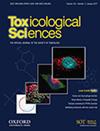Chronic exposure to BDE-47 aggravates acute pancreatitis and chronic pancreatitis by promoting acinar cell apoptosis and inflammation
IF 3.4
3区 医学
Q2 TOXICOLOGY
引用次数: 0
Abstract
The effect of 2,2',4,4'-Tetrabromodiphenyl ether (BDE-47), a persistent environmental pollutant commonly used as a flame retardant in various consumer products, on pancreatitis has not been clearly elucidated, although it has been reported to be toxic to the liver, nervous system, and reproductive system. Acute pancreatitis (AP) and chronic pancreatitis (CP) models were induced in this study by intraperitoneal injection of caerulein. The aim was to investigate the impact of BDE-47 on pancreatitis by exposing the animals to acute (1 week) or chronic (8 weeks) doses of BDE-47 (30 mg/kg in the low-concentration group and 100 mg/kg in the high-concentration group). Additionally, BDE-47 was utilized to stimulate mouse bone marrow derived macrophages, pancreatic primary stellate cells, and acinar cells in order to investigate the impact of BDE-47 on pancreatitis. In vivo experiments conducted on mice revealed that chronic exposure to BDE-47, rather than acute exposure, exacerbated the histopathological damage of AP and CP, leading to elevated fibrosis in pancreatic tissue and increased infiltration of inflammatory cells in the pancreas. In vitro experiments showed that BDE-47 can promote the expression of the inflammatory cytokines Tnf-α and Il-6 in M1 macrophages, as well as promote acinar cell apoptosis through the activation of the PERK and JNK pathways via endoplasmic reticulum stress. The findings of this study imply chronic exposure to BDE-47 may exacerbate the progression of both AP and CP by inducing acinar cell apoptosis and dysregulating inflammatory responses.长期暴露于 BDE-47 会促进胰腺尖细胞凋亡和炎症,从而加重急性胰腺炎和慢性胰腺炎的病情
2,2',4,4'-四溴二苯醚(BDE-47)是一种持久性环境污染物,常用于各种消费品的阻燃剂,尽管有报道称它对肝脏、神经系统和生殖系统有毒性,但其对胰腺炎的影响尚未明确阐明。本研究通过腹腔注射凯鲁灵诱导急性胰腺炎(AP)和慢性胰腺炎(CP)模型。目的是通过让动物接触急性(1周)或慢性(8周)剂量的BDE-47(低浓度组为30毫克/千克,高浓度组为100毫克/千克),研究BDE-47对胰腺炎的影响。此外,为了研究 BDE-47 对胰腺炎的影响,还利用 BDE-47 刺激小鼠骨髓衍生的巨噬细胞、胰腺原发性星状细胞和尖突细胞。在小鼠身上进行的体内实验表明,长期暴露于 BDE-47 而不是急性暴露,会加剧 AP 和 CP 的组织病理学损伤,导致胰腺组织纤维化加重,胰腺中的炎性细胞浸润增加。体外实验表明,BDE-47可促进M1巨噬细胞中炎性细胞因子Tnf-α和Il-6的表达,并通过内质网应激激活PERK和JNK通路,促进胰腺细胞凋亡。这项研究的结果表明,长期暴露于BDE-47可能会通过诱导尖顶细胞凋亡和炎症反应失调而加剧AP和CP的进展。
本文章由计算机程序翻译,如有差异,请以英文原文为准。
求助全文
约1分钟内获得全文
求助全文
来源期刊

Toxicological Sciences
医学-毒理学
CiteScore
7.70
自引率
7.90%
发文量
118
审稿时长
1.5 months
期刊介绍:
The mission of Toxicological Sciences, the official journal of the Society of Toxicology, is to publish a broad spectrum of impactful research in the field of toxicology.
The primary focus of Toxicological Sciences is on original research articles. The journal also provides expert insight via contemporary and systematic reviews, as well as forum articles and editorial content that addresses important topics in the field.
The scope of Toxicological Sciences is focused on a broad spectrum of impactful toxicological research that will advance the multidisciplinary field of toxicology ranging from basic research to model development and application, and decision making. Submissions will include diverse technologies and approaches including, but not limited to: bioinformatics and computational biology, biochemistry, exposure science, histopathology, mass spectrometry, molecular biology, population-based sciences, tissue and cell-based systems, and whole-animal studies. Integrative approaches that combine realistic exposure scenarios with impactful analyses that move the field forward are encouraged.
 求助内容:
求助内容: 应助结果提醒方式:
应助结果提醒方式:


